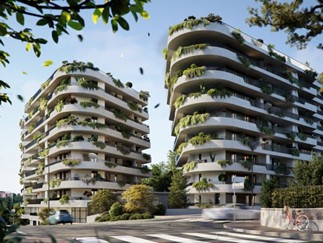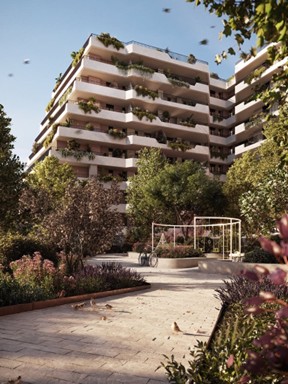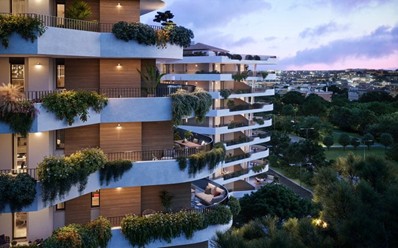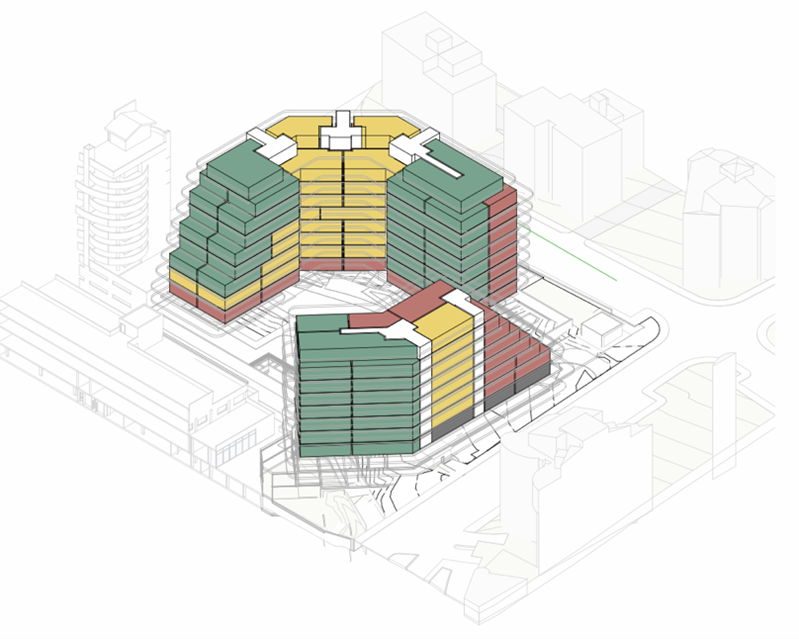MASTER: Project management in construction works with BIM
AUTHOR: Arch. Ozlem Bozkaya
TUTOR: Eng. Giovanni Franchi
The Talenti district of Rome is set to host a new urban oasis where innovative architecture and nature converge in a unique residential project. Designed by Vittorio Grassi Architects, the *Terrazze Talenti* complex introduces a novel vision of urban living, oriented towards sustainability and environmental harmony.
Sustainability, comfort, and modernity constitute the core principles of this ambitious development, which will comprise two nine-story residential structures overlooking *Parco Talenti*, a 44-hectare public green space that provides a serene environment in close proximity to the dynamic urban landscape. Situated just 20 minutes from the city center and well connected to Rome’s primary transportation networks, *Terrazze Talenti* epitomizes the synthesis of natural integration and urban accessibility.
Distinguished by its fluid architectural forms and the use of sustainable materials, the project features composite wood facades and expansive continuous balconies, fostering an uninterrupted visual and spatial relationship with the surrounding greenery. The development will house 187 residential units, ranging from one-bedroom to three-bedroom apartments, as well as exclusive penthouses, all meticulously designed to offer spacious, well-lit, and functionally optimized interiors. Each aspect of the design is carefully conceived to harmonize natural well-being with contemporary living standards.
The residences will incorporate advanced energy-efficient technologies, including high-performance independent heating and cooling systems that enable precise thermal regulation. Additionally, the residential complex will offer a diverse array of amenities, including fitness facilities, co-working spaces, a children’s playground, and dedicated areas for pet care. These features collectively establish *Terrazze Talenti* as an exemplary model of equilibrium between family life, environmental sustainability, and modern urban living. between family life, environmental sustainability, and modern urban living.
The “Terrazze Talenti” residential project serves as a significant case study to understand the impact of BIM methodology and project management techniques on the development and execution of a construction project. The initial design, developed without BIM, failed to meet the client’s expectations, leading to a complete project restart with implementation of BIM methodology.
This thesis analyzes the differences between the two design approaches, highlighting the benefits of BIM implementation and structured project management. The first chapter explores the theoretical foundations of BIM philosophy and the challenges encountered in the original project. The second chapter focuses on the practical application of BIM, detailing the tools used in the new project development. Finally, the third chapter examines the role of project management and its impact on project execution, demonstrating how strategic planning and BIM-based workflows improve quality, time management, and cost control.
The analysis confirms that an integrated approach, combining BIM and project management, optimizes the entire project lifecycle—from design to construction—ensuring better outcomes and higher client satisfaction.
The future of the construction sector is increasingly shaped by the integration of Building Information Modeling (BIM) with advanced Project Management (PM) techniques. As technology evolves, BIM is expected to expand beyond its traditional 3D modeling role to become a fully integrated digital platform that synchronizes design, scheduling, cost control, risk management, and sustainability analysis within a single environment.
Key Future Trends:
Full Lifecycle BIM Implementation (6D & 7D BIM)
BIM will extend beyond 4D (time) and 5D (cost) to 6D (sustainability/energy performance) and 7D (facilities management), ensuring seamless information flow from design to operations and maintenance.
AI and Automation in BIM & PM
Artificial Intelligence (AI) and Machine Learning (ML) will be integrated into BIM platforms to automate risk assessments, optimize schedules, and predict potential project delays based on historical data.
Cloud-Based Collaborative Workflows
The use of Common Data Environments (CDEs) and cloud-based BIM platforms will enhance real-time collaboration between project stakeholders, reducing miscommunication and rework.
BIM-Driven Decision-Making in Project Management
Project management techniques such as Earned Value Management (EVM), Lean Construction, and Agile Project Management will be enhanced by BIM’s real-time visualization and data analytics, leading to more proactive project controls.
Integration of IoT and Digital Twins
The Internet of Things (IoT) and Digital Twin technology will allow construction teams to monitor real-world project performance through BIM models, improving real-time decision-making and asset management.
Standardization & Regulation Growth
With the increasing adoption of ISO 19650 and other global BIM standards, construction firms will need to align their project workflows with structured data-sharing protocols, ensuring consistency and efficiency in multi-disciplinary collaboration.
Final Thoughts
The convergence of BIM and Project Management techniques is set to revolutionize how construction projects are planned, executed, and maintained. The industry will move toward a data-driven, highly automated, and collaborative environment, reducing costs, improving efficiency, and enhancing project predictability. Organizations that adapt to these advancements and invest in digital transformation will gain a competitive edge in the evolving construction landscape.
figure 1: The Talenti district of Rome is set to host a new urban oasis where innovative architecture and nature converge in a unique residential project. Designed by Vittorio Grassi Architects, the *Terrazze Talenti* complex introduces a novel vision of urban living, oriented towards sustainability and environmental harmony.
figure 2: Sustainability, comfort, and modernity constitute the core principles of this ambitious development, which will comprise two nine-story residential structures overlooking *Parco Talenti*, a 44-hectare public green space that provides a serene environment in close proximity to the dynamic urban landscape. Situated just 20 minutes from the city center and well connected to Rome’s primary transportation networks, *Terrazze Talenti* epitomizes the synthesis of natural integration and urban accessibility.
figure 3: The “Terrazze Talenti” residential project serves as a significant case study to understand the impact of BIM methodology and project management techniques on the development and execution of a construction project. The initial design, developed without BIM, failed to meet the client’s expectations, leading to a complete project restart with implementation of BIM methodology.




